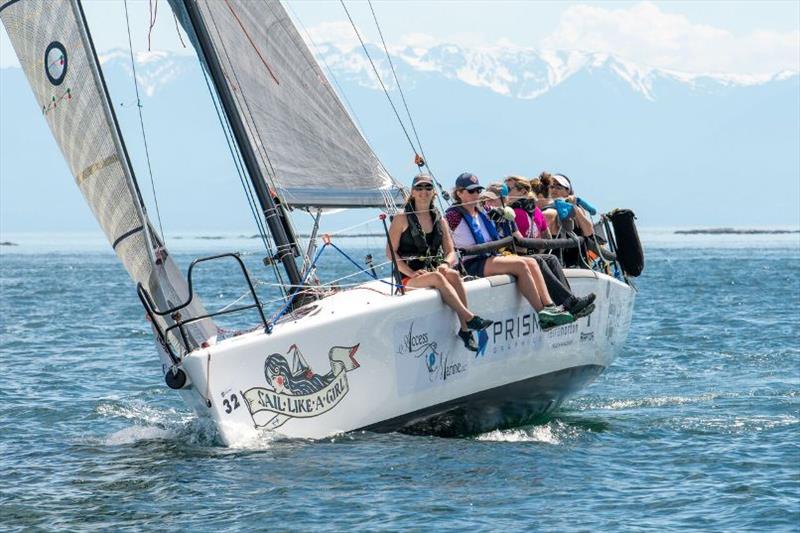
Celebrating the R2AK's unique brew of adventure and adrenaline
by David Schmidt 4 Jun 2019 08:00 PDT
June 4, 2019

Sail Like A Girl – Race to Alaska 2018 © Katrina Zoe Norbom / racetoalaska.com
June's arrival in the Pacific Northwest is a special time thanks to the area's unique sailing scene that includes events such as the Van Isle 360 (odd-numbered years), the Victoria to Maui International Yacht Race (even-numbered years), and the annual Race to Alaska (R2AK), the latter of which began yesterday (Monday, June 3) on the waters off of Port Townsend, Washington. While the former two races are exciting, the R2AK's rules add a significant level of commitment by forbidding competitors from sailing with engines. And we're not talking the honor system here: to be eligible to compete in the R2AK, a boat cannot carry auxiliary power, irrespective of the rocky and remote lee shores (sometimes populated with grizzly bears) that are part of the R2AK experience.
Granted, a boat sailing to Maui can't exactly switch on the iron jenny if the airs get light at the halfway mark (unless they modified their interior to include significant amounts of extra tankage), but they also don't (typically) need to worry about huge amounts of commercial traffic, commercial fishing boats, and boat-eating rocks for the bulk of their racecourse.
Then there's Seymour Narrows, a spot on the chart just north of the British Columbian fishing town of Campbell River, where tidal swings can generate up to 15 knots of positive or negative water, and where even whales are said to wait for favorable waters to make their passage.
So, it's fair to say that travelling to Alaska under human power (R2AK rules allow for paddles, peddle-driven paddles and sails) adds a significant complicating factor to the race while also testing each competitor's commitment to the dream with ample exposure to cold water, notoriously fickle winds, and plenty of hard-won local knowledge.
Still, not everyone is sold on the R2AK's merits. For example, a few weeks ago I was sailing with a well-known Seattle sailmaker and high-end small-boat sailor who essentially scoffed at the race, referring to it as more of an adventure cruise than a competitive event that truly tests sailing acumen. Fair enough - that's what endless windward-leeward racing is for (and Lord knows there's no shortage of those). But, when I pressed this sailor about the R2AK's adventure-racing aspects, his polished dinghy-sailor veneer fell away. "I mean, I guess I'll do it someday," he said with a thin smile. "I mean it's right here, in my backyard. And it does look pretty cool."
So, if you're looking to find the fastest small-boat guns afloat, one would do better to look at events such as the J/70 or the Melges 24 Worlds. But, if one is equally interested in adventure and seamanship as they are in making a boat jump, the R2AK stands ready to woo.
Part of this wooing is compliments of the bold, ambitious, and downright romantic idea of travelling under human power to Alaska, but part of the gravity also comes from the race's fantastic media engagement. This started in the pre-race days with great team profiles and continues with lively, pithy, and occasionally salty, daily briefings.
This media engagement allows local, national and international audiences to follow the action and to get drawn into the drama and the eternal question: What's the right whip for the trip: one with one, two or three hulls?
Interestingly, all three types of craft have claimed the race's $10,000 cash prize, however it's important to note that a monohull has only won once since the race's inception (2018). That said, the bulk of these same bad-ass monohull sailors have returned this year to defend their hard-fought title.
Then there's the obvious: cold, hypothermia-inducing water, wilderness coastlines, wild-card weather, and a serious need for self-sustainability.
These cruxes attract a certain, slightly off-of-center type of sailor, and I'm proud to report that these are some of the best people that I've met in our sport. While I've only done the first leg of the 2015 R2AK (from Port Townsend to Victoria, on the southern tip of Vancouver Island) as a journalist aboard a small proa, I have had the opportunity to interview several winning teams, all of whom are plenty competitive on more traditional windward-leeward courses, and they all share a strong love for stepping out into the unknown while pressing on as much canvas as possible.
So, if this sounds like your kind of Kool-Aid, pour yourself an extra big glass and settle in, as the 2019 R2AK began yesterday with the qualifying leg from Port Townsend to Victoria. Next up, on Thursday, June 6, the fleet will begin the 710 nautical mile leg to Ketchikan, which is first marked by the all-out sprint to make it through Seymour Narrows before the tidal window shuts and the water machine forces boats to circle above the whales. Then comes the dash for the cash (and Ketchikan).
So, while we at Sail-World understand that the R2AK isn't the best test for determining windward-leeward speed, we also suspect that plenty of red-hot buoy racers might find themselves instantly humbled by the Pacific Northwest's cold water, challenging weather, and massive tides and currents.
Sail-World wishes safe and speedy passage to all R2AK participants, and we also encourage all readers to sample the R2AK's Kool-Aid, even if only in the form of armchair sailing. It might not be to everyone's liking, but we suspect that more than one sailor will discover some personal electricity in the R2AK's pungent brew of adrenaline, adventure, and no auxiliary engines.
May the four winds blow you safely home.
David Schmidt
Sail-World.com North American Editor